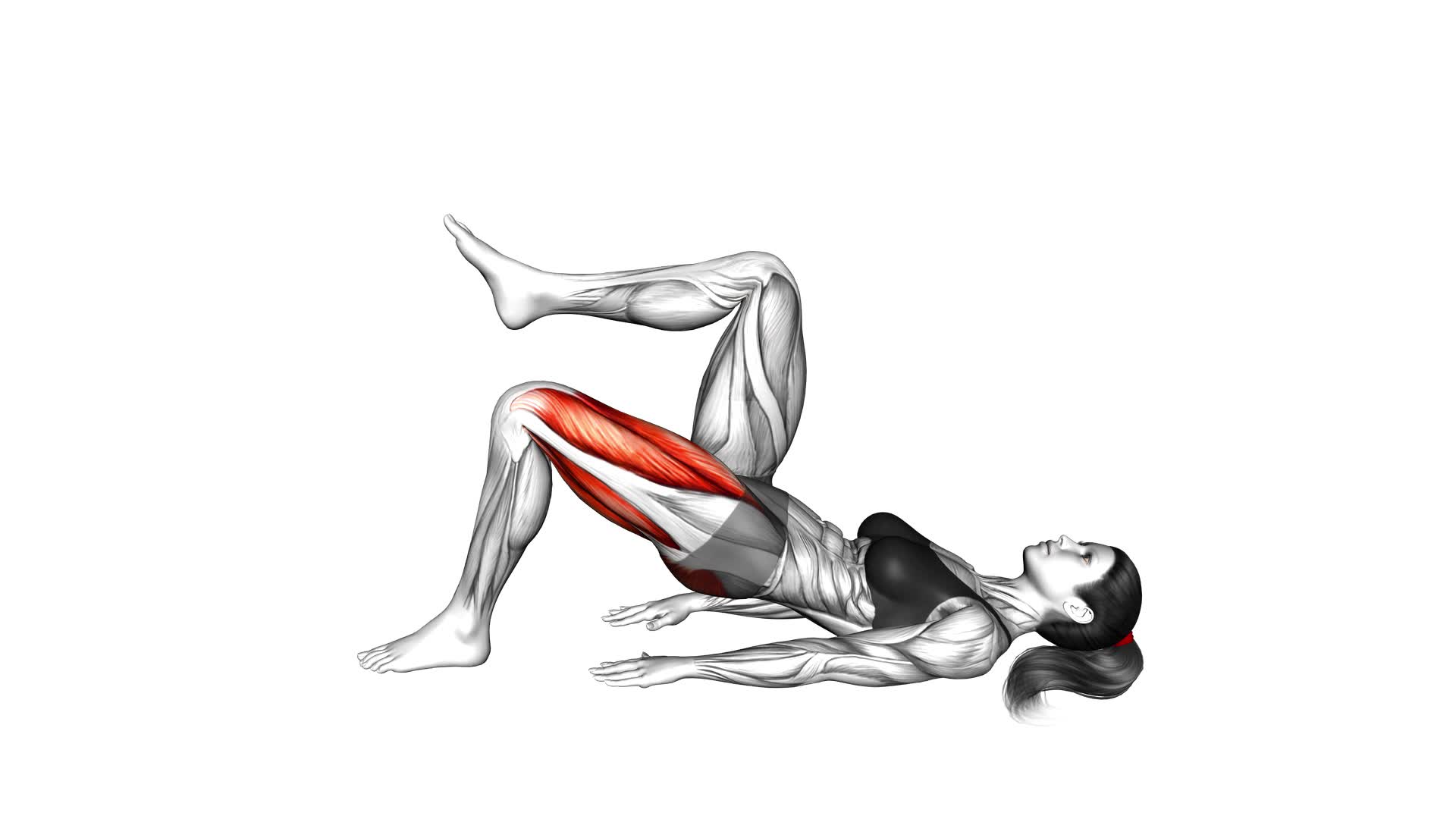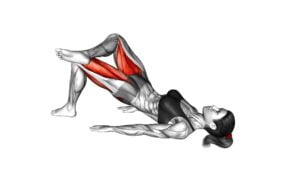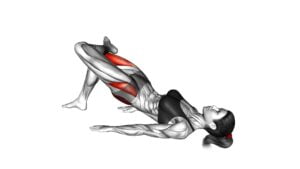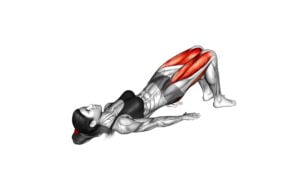Glute Bridge One Leg on Floor (Bent Knee) (Female) – Video Exercise Guide & Tips

Get ready to tone and strengthen your glutes with the Glute Bridge One Leg on Floor (Bent Knee) exercise! In this video exercise guide, we'll show you the proper form and technique to maximize the effectiveness of this exercise.
Watch This Exercise Video
Avoid common mistakes and discover progressions and variations to challenge yourself. Follow our tips and get the most out of your Glute Bridge One Leg on Floor (Bent Knee) workout routine.
Let's get started!
Key Takeaways
- Glute Bridge One Leg on Floor (Bent Knee) exercise strengthens and tones the glutes.
- It improves lower body strength, stability, and core stability.
- This exercise increases hip mobility and flexibility, reducing the risk of lower back pain.
- Proper form and technique, such as maintaining proper knee alignment and engaging the glute muscles, are essential for maximum effectiveness.
Benefits of Glute Bridge One Leg on Floor (Bent Knee) Exercise
By incorporating the Glute Bridge One Leg on Floor (Bent Knee) Exercise into your workout routine, you can experience numerous benefits. This exercise has several variations that target different muscle groups, allowing you to customize your workout and achieve your fitness goals.
One of the primary benefits of this exercise is its ability to strengthen and tone your glutes. By activating the glute muscles, you can improve your overall lower body strength and stability.
Additionally, the Glute Bridge One Leg on Floor (Bent Knee) Exercise helps to improve core stability and balance. It engages your core muscles, promoting better posture and reducing the risk of lower back pain.
This exercise is also beneficial for improving hip mobility and flexibility. Proper form and technique are essential when performing the Glute Bridge One Leg on Floor (Bent Knee) Exercise. Ensure that your hips are lifted and your glutes are engaged throughout the movement. Maintain a neutral spine and avoid overarching or rounding your back.
Transitioning smoothly into the subsequent section about proper form and technique, it's crucial to focus on these key aspects to maximize the benefits of this exercise.
Proper Form and Technique for Glute Bridge One Leg on Floor (Bent Knee)
To perform the Glute Bridge One Leg on Floor (Bent Knee) exercise with proper form and technique, you should use a slight bend in your knee and follow these instructions:
- Lie on your back with your knees bent and feet flat on the floor, hip-width apart.
- Extend one leg straight out in front of you, keeping a slight bend in the knee.
- Engage your glute muscles and lift your hips off the ground until your body forms a straight line from your knees to your shoulders.
- Hold the position for a few seconds, then slowly lower your hips back down to the starting position.
Remember to maintain proper breathing technique throughout the exercise. Inhale as you lower your hips and exhale as you lift your hips off the ground.
There are a few common misconceptions to be aware of when performing the Glute Bridge One Leg on Floor (Bent Knee) exercise. It's important to avoid arching your lower back or using momentum to lift your hips. Focus on using your glute muscles to drive the movement and keep your core engaged for stability.
Next, let's discuss the common mistakes to avoid during the Glute Bridge One Leg on Floor (Bent Knee) exercise.
Common Mistakes to Avoid During Glute Bridge One Leg on Floor (Bent Knee)
To perform the Glute Bridge One Leg on Floor (Bent Knee) exercise correctly, make sure to avoid common mistakes such as incorrect knee alignment, lack of hip extension, and insufficient glute activation.
Keep your knee in line with your toes to prevent strain on the knee joint. Fully extend your hip at the top of the movement to engage the glutes effectively.
Activate your glutes throughout the exercise by consciously squeezing them at the top position.
Incorrect Knee Alignment
Avoid bending your knee too far inward during the Glute Bridge One Leg on Floor (Bent Knee) exercise. Incorrect knee alignment can lead to knee pain and potential injury. Here are some common mistakes to avoid and tips for correcting knee alignment:
- Knees collapsing inward: Keep your knees in line with your hips and ankles. Imagine a straight line from your hip to your knee to your ankle.
- Knees splaying out: Avoid letting your knees drift outwards. Keep them in line with your hips and ankles for proper alignment.
- Uneven weight distribution: Make sure to distribute your weight evenly between your supporting foot and the foot on the floor. This will help maintain proper knee alignment.
Lack of Hip Extension
Maintain proper hip extension by ensuring your knee, hip, and ankle stay aligned during the Glute Bridge One Leg on Floor (Bent Knee) exercise.
Hip extension is crucial for maximizing the effectiveness of this exercise and targeting your glute muscles. When your knee, hip, and ankle are aligned, it allows for optimal hip flexibility and mobility, enabling you to fully engage your glutes.
If there's a lack of hip extension, it can lead to compensations and improper muscle activation, reducing the benefits of the exercise. To improve hip extension, focus on keeping your body in a straight line from your knee to your hip to your ankle throughout the movement.
This will help you achieve better results and prevent any potential injuries.
Now, let's move on to the next section about insufficient glute activation.
Insufficient Glute Activation
Make sure you're properly activating your glutes while performing the Glute Bridge One Leg on Floor (Bent Knee) exercise by avoiding these common mistakes:
- Not squeezing your glutes at the top: To maximize glute activation, focus on squeezing your glutes as you lift your hips off the ground. This will help target and engage the glute muscles effectively.
- Allowing your knees to cave in: Keep your knees in line with your hips and ankles throughout the movement. Allowing your knees to collapse inward can reduce glute activation and put unnecessary strain on your knees.
- Using momentum instead of control: Avoid using momentum to lift your hips off the ground. Instead, focus on using your glute muscles to initiate the movement and control the motion throughout the exercise.
Progressions and Variations of Glute Bridge One Leg on Floor (Bent Knee)
To challenge yourself and enhance the effectiveness of the exercise, try incorporating advanced variations and progressions of the Glute Bridge One Leg on Floor (Bent Knee) movement.
These progressions and modifications will help you take your glute training to the next level.
One progression you can try is the Glute Bridge One Leg on Floor with Resistance Band. To do this, simply place a resistance band around your knees and perform the exercise as usual. The resistance band adds an extra challenge by requiring your glutes to work harder to maintain proper form.
Another variation is the Glute Bridge One Leg on Floor with Weight. To do this, hold a dumbbell or kettlebell on your hips as you perform the exercise. The added weight increases the resistance and further stimulates your glute muscles.
You can also try the Glute Bridge One Leg on Floor with Stability Ball. Place a stability ball between your feet and squeeze it as you lift your hips off the ground. This variation not only targets your glutes but also engages your core and improves stability.
By incorporating these progressions and variations, you can continue to challenge and stimulate your glutes, leading to better strength and muscle development.
Remember to start with the basic Glute Bridge One Leg on Floor movement and gradually progress to these advanced variations as you become more comfortable and stronger.
Tips for Maximizing the Effectiveness of Glute Bridge One Leg on Floor (Bent Knee)
To maximize the effectiveness of the Glute Bridge One Leg on Floor (Bent Knee) exercise, focus on engaging your glute muscles throughout the movement. Here are some tips to help you maximize activation and get the most out of your workout:
- Squeeze your glutes: As you lift your hips off the floor, focus on squeezing your glute muscles. This will help to activate and strengthen them even more.
- Maintain proper alignment: Keep your knees in line with your hips and ankles throughout the exercise. This will ensure that you're targeting your glutes effectively and minimizing strain on other muscles.
- Control the movement: Slow and controlled movements are key to maximizing the effectiveness of the glute bridge. Avoid using momentum or relying on other muscles to lift your hips. Instead, focus on using your glutes to lift and lower your body.
By following these tips, you can enhance the activation of your glute muscles during the Glute Bridge One Leg on Floor (Bent Knee) exercise.
Sample Glute Bridge One Leg on Floor (Bent Knee) Workout Routine
To optimize your glute bridge one leg on floor (bent knee) workout routine, prioritize consistency and progression. Consistency is key to seeing results, so aim to perform this exercise at least two to three times per week. Start with a weight that challenges you but allows you to maintain proper form throughout the movement. As you become more comfortable and stronger, gradually increase the weight or resistance to continue challenging your glutes.
For beginners, it's important to focus on mastering the basic glute bridge before attempting modifications. Start by lying on your back with your knees bent and feet flat on the floor. Lift one leg off the ground, keeping the knee bent at a 90-degree angle. Engage your glutes and drive your hips up towards the ceiling, squeezing your glutes at the top. Lower your hips back down and repeat for the desired number of repetitions before switching legs.
To modify the glute bridge, you can use a resistance band around your thighs to add extra resistance. Alternatively, you can place a weight or a barbell across your hips to increase the intensity of the exercise. Remember to always listen to your body and start with lighter weights or resistance bands if you're unsure of your strength level.
With consistency and progressive overload, you'll be on your way to stronger and more sculpted glutes.
Frequently Asked Questions
Can I Perform the Glute Bridge One Leg on Floor (Bent Knee) Exercise if I Have Knee Pain or Injuries?
Yes, you can still perform the glute bridge one leg on the floor exercise even if you have knee pain or injuries. However, it's important to modify the exercise to accommodate your condition.
You can try using a pillow or a folded towel under your knee for added support. Additionally, it's recommended to consult with a healthcare professional or a certified trainer for personalized modifications and guidance.
Incorporating this exercise into your workout routine can help strengthen your glutes and improve overall lower body stability.
How Many Repetitions and Sets Should I Aim for When Incorporating the Glute Bridge One Leg on Floor (Bent Knee) Exercise Into My Workout Routine?
When incorporating the glute bridge one leg on the floor (bent knee) exercise into your workout routine, aim for 3 sets of 10 to 15 repetitions. This will help target your glutes effectively.
However, if you have knee pain or injuries, it's important to modify the exercise accordingly. You can try reducing the range of motion or using a resistance band for added support.
Always listen to your body and consult a professional if needed.
Can I Perform the Glute Bridge One Leg on Floor (Bent Knee) Exercise With a Resistance Band or Weight for Added Difficulty?
Yes, you can definitely perform the glute bridge one leg on floor (bent knee) exercise with a resistance band or weight for added difficulty. This is a great way to challenge your glutes and make the exercise more effective.
If you want to modify the exercise, you can also try alternative glute exercises such as hip thrusts or Bulgarian split squats. These exercises can target your glutes in a similar way and provide you with variety in your workout routine.
Is It Necessary to Engage My Core Muscles During the Glute Bridge One Leg on Floor (Bent Knee) Exercise?
Engaging your core muscles during the glute bridge one leg on floor (bent knee) exercise is essential. It helps stabilize your body and maintain proper form, preventing any unnecessary strain on your back.
Additionally, core engagement enhances the effectiveness of the exercise by targeting the deep core muscles, promoting better balance and overall stability.
Can I Perform the Glute Bridge One Leg on Floor (Bent Knee) Exercise as a Warm-Up Before Other Lower Body Exercises?
Yes, you can definitely perform the glute bridge one leg on the floor (bent knee) exercise as a warm-up before other lower body exercises. It's a great way to activate your glutes and prepare them for the upcoming workout.
Incorporating glute activation exercises into your warm-up routine can help improve your overall lower body strength and stability.
If you're looking for alternative warm-up exercises for lower body workouts, the glute bridge is a highly effective option.
Conclusion
In conclusion, the glute bridge one leg on floor (bent knee) exercise is a highly effective workout for targeting and strengthening the gluteal muscles.
By maintaining proper form and technique, avoiding common mistakes, and incorporating progressions and variations, you can maximize the effectiveness of this exercise.
Remember to focus on engaging your glutes and maintaining a stable core throughout the movement.
By incorporating this exercise into your workout routine, you can achieve stronger and more sculpted glutes.

Author
Years ago, the spark of my life’s passion ignited in my mind the moment I stepped into the local gym for the first time. The inaugural bead of perspiration, the initial endeavor, the very first surge of endorphins, and a sense of pride that washed over me post-workout marked the beginning of my deep-seated interest in strength sports, fitness, and sports nutrition. This very curiosity blossomed rapidly into a profound fascination, propelling me to earn a Master’s degree in Physical Education from the Academy of Physical Education in Krakow, followed by a Sports Manager diploma from the Jagiellonian University. My journey of growth led me to gain more specialized qualifications, such as being a certified personal trainer with a focus on sports dietetics, a lifeguard, and an instructor for wellness and corrective gymnastics. Theoretical knowledge paired seamlessly with practical experience, reinforcing my belief that the transformation of individuals under my guidance was also a reflection of my personal growth. This belief holds true even today. Each day, I strive to push the boundaries and explore new realms. These realms gently elevate me to greater heights. The unique combination of passion for my field and the continuous quest for growth fuels my drive to break new ground.







